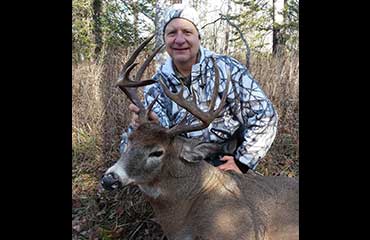Hunting big-woods deer has been a passion of mine since I first began whitetailing some 40 years ago, and the excitement hasn’t waned. One who would agree is Brad Kuhnert, who has lived in far northern Wisconsin for the past 40 years and has bagged some very impressive bucks there.
Now in his 60s, Kuhnert has worked with Lone Wolf Custom Gear to develop a saddle-hunting platform he perfected in the big woods, and later this year they’ll be introducing an all-new saddle harness he believes will greatly simplify that specialized pursuit.
Following are few of Kuhnert’s favorite bigwoods tips.
Hunt Where You Have To
Like many big-buck experts, Kuhnert is adept at reading sign, and he knows the difference between hunting where you have the best chance for success, versus where a tree will let you. That’s why Kuhnert was a pioneer of saddle hunting back in the ‘80s — a tactic he continues to promote today.
“A lot of the areas I was hunting in northern Wisconsin were slashings next to hardwoods, and out in those slashings, it’s hard to find a tree that can support any kind of standard hang-on stand. But with a saddle and small platform, I can get in most any tree in the woods.”
Large Tracks Don’t Lie
One of the key signs Kuhnert looks for in a mature big-woods buck is track size. And although you likely can find hunters who believe large tracks don’t automatically equate to a large buck — or even a buck versus a doe — that’s not been Kuhnert’s experience. In Kuhnert’s big-woods haunts, big tracks mean big bucks, and once found it’s time to piece together the deer’s preferred trails and travel patterns.
A Favorite Strategy
Earlier this spring I wrote about funneling deer to your stand sites by taking time to strategically arrange downed logs and brush. Interestingly, Kuhnert employs a variation of this strategy in the big woods, geared toward a very specific goal. In spring, when he finds what he believes is a big-buck trail, Kuhnert uses downed branches and logs to block a portion of the trail, to force the deer using it to travel north and south for several yards.
“The reason I want the buck to travel north and south, is because the prevailing wind in my hunting area is from the west. So I can set up on the east side of that trail but if things change I can just take my saddle and in 10-15 minutes, move to the west side. You don’t often find areas where those big mature deer are traveling crosswind, but with this setup I have a real advantage.”
Now in his 60s, Kuhnert has worked with Lone Wolf Custom Gear to develop a saddle-hunting platform he perfected in the big woods, and later this year they’ll be introducing an all-new saddle harness he believes will greatly simplify that specialized pursuit.
Following are few of Kuhnert’s favorite bigwoods tips.
Hunt Where You Have To
Like many big-buck experts, Kuhnert is adept at reading sign, and he knows the difference between hunting where you have the best chance for success, versus where a tree will let you. That’s why Kuhnert was a pioneer of saddle hunting back in the ‘80s — a tactic he continues to promote today.
“A lot of the areas I was hunting in northern Wisconsin were slashings next to hardwoods, and out in those slashings, it’s hard to find a tree that can support any kind of standard hang-on stand. But with a saddle and small platform, I can get in most any tree in the woods.”
Large Tracks Don’t Lie
One of the key signs Kuhnert looks for in a mature big-woods buck is track size. And although you likely can find hunters who believe large tracks don’t automatically equate to a large buck — or even a buck versus a doe — that’s not been Kuhnert’s experience. In Kuhnert’s big-woods haunts, big tracks mean big bucks, and once found it’s time to piece together the deer’s preferred trails and travel patterns.
A Favorite Strategy
Earlier this spring I wrote about funneling deer to your stand sites by taking time to strategically arrange downed logs and brush. Interestingly, Kuhnert employs a variation of this strategy in the big woods, geared toward a very specific goal. In spring, when he finds what he believes is a big-buck trail, Kuhnert uses downed branches and logs to block a portion of the trail, to force the deer using it to travel north and south for several yards.
“The reason I want the buck to travel north and south, is because the prevailing wind in my hunting area is from the west. So I can set up on the east side of that trail but if things change I can just take my saddle and in 10-15 minutes, move to the west side. You don’t often find areas where those big mature deer are traveling crosswind, but with this setup I have a real advantage.”




.png)